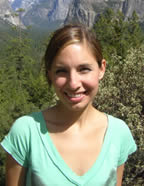Graduate Student Receives National Recognition
Rebecca Hernandez will use fellowship to study soil crusts in local ecosystems
December 12, 2006
By Debra Cano Ramos
Graduate student Rebecca Hernandez has found herself in a league of her own. She is this year’s only American recipient of the Pruitt National Minority Fellowship Program grant from the Society of Women Geographers (SWG).
The annual award, named after longtime SWG member Evelyn L. Pruitt who died in 2000, is given to a minority woman enrolled in a master’s program in geography or a related field. Pruitt was a geographer for the U.S. Navy and her work advanced the study of coastal environments.
Hernandez, who works in the lab of Darren Sandquist, associate professor of biological science, is using the $5,000 cash prize for her research efforts on biological soil crusts and the effects of their disturbance in coastal sage scrub ecosystems.
She is conducting her fieldwork at Limestone Canyons & Whiting Ranch Wilderness Park in southeast Orange County — a preserve dominated by coastal sage scrub stands.
Biological invasions are the second biggest cause of biodiversity loss in the United States — after habitat destruction — and are a significant component of global environmental change, Hernandez explained. In Southern California, exotic plants have invaded coastal sage scrub communities, causing a permanent shift in the community composition from native perennial shrubland to exotic annual grassland.
The cause for this rapid invasion is still unknown, she said. However, her study seeks to find out whether disturbance of the soil, specifically biological soil crusts, increases the germination of exotic annual grasses and forbs — a broad-leaved herb other than a grass — into these habitats. Biological crusts are a fragile group of cyanobacteria, also known as blue-green algae, as well as lichen, green algae, moss and fungi that exist within the top of the soil, Hernandez said.
Studies examining the relationship between biological soil crusts and germination of exotic plants suggest that disturbance of soil crusts increases the germination of exotic plants, while undisturbed crusts inhibit germination of exotic plants, she added.
Within this plant community, Hernandez, who has a bachelor’s degree in geography from UCLA, will identify the dominant organisms found in these soil crust collections. “I will then use a series of field and greenhouse studies to test my hypothesis that disturbance of biological soil crusts in coastal sage scrub communities increases the germination densities of exotic plants.”
Hernandez hopes that her research, expected to be completed in about a year, will help the Limestone Canyons & Whiting Ranch Wilderness Park, as well as land managers across the country, to better manage and preserve these important soil communities and improve overall ecosystem health.


 Produced by the Office of Public Affairs at California State University, Fullerton.
Produced by the Office of Public Affairs at California State University, Fullerton.